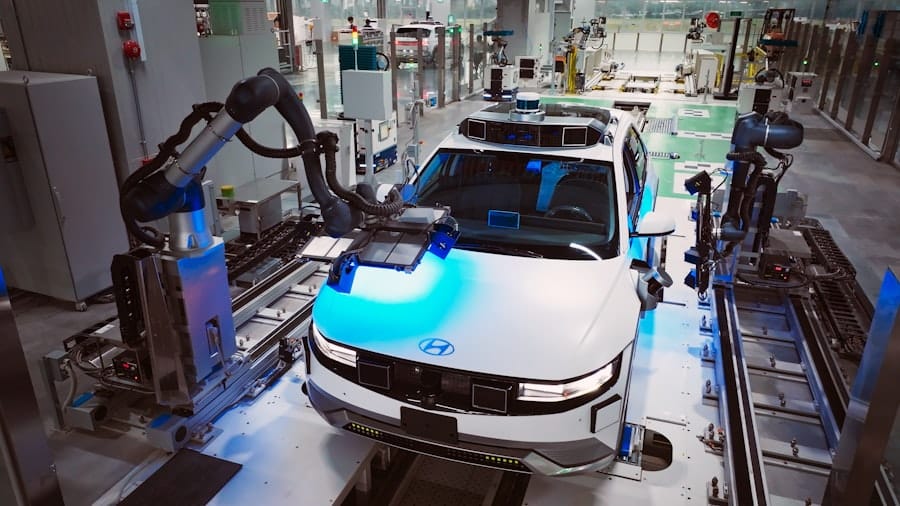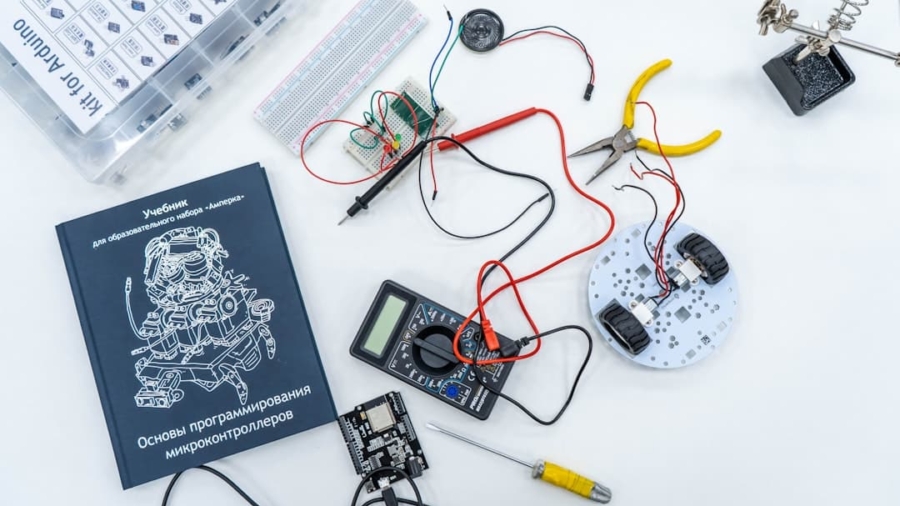The advent of robotics has revolutionized various sectors, with high-risk manufacturing industries standing out as a primary beneficiary of this technological evolution. High-risk manufacturing environments, such as those found in chemical processing, metal fabrication, and heavy machinery production, often expose human workers to hazardous conditions. These environments are characterized by the potential for accidents, exposure to toxic substances, and the handling of heavy machinery, which can lead to severe injuries or fatalities.
As a response to these challenges, the integration of robotics has emerged as a pivotal strategy to enhance operational efficiency while safeguarding human workers. Robotics in high-risk manufacturing is not merely about replacing human labor; it is about augmenting human capabilities and creating a safer workplace. The deployment of robotic systems can significantly reduce the likelihood of accidents by taking over dangerous tasks that would otherwise put human workers at risk.
For instance, robots can be programmed to handle toxic materials or operate in extreme temperatures, thereby minimizing human exposure to hazardous conditions. This shift not only protects workers but also enhances productivity and operational reliability, making robotics an indispensable component of modern high-risk manufacturing.
Key Takeaways
- Robotics play a crucial role in improving safety and efficiency in high-risk manufacturing industries.
- Implementing robotics in high-risk manufacturing facilities can lead to significant improvements in safety, productivity, and quality.
- The benefits of using robotics in high-risk manufacturing industries include increased safety, reduced human error, and improved efficiency, but challenges such as high initial costs and technical limitations need to be addressed.
- The successful integration of robotics in high-risk manufacturing processes can serve as a model for other industries looking to improve safety and productivity.
- Ethical and social implications of robotics in high-risk manufacturing industries need to be carefully considered to ensure the well-being of workers and the community.
The Role of Robotics in Improving Safety in High-Risk Manufacturing Environments
Robotics plays a crucial role in enhancing safety within high-risk manufacturing environments by automating tasks that pose significant dangers to human workers. One of the most notable applications is in the handling of hazardous materials. For example, in chemical manufacturing plants, robots equipped with specialized sensors and tools can manage the transfer of corrosive substances without exposing employees to harmful fumes or spills.
This automation not only mitigates the risk of chemical burns or inhalation injuries but also ensures compliance with stringent safety regulations. Moreover, robotics can be employed in environments where heavy machinery is prevalent. Automated guided vehicles (AGVs) and robotic arms can transport heavy loads or perform intricate assembly tasks that would otherwise require human intervention.
By utilizing these machines, manufacturers can reduce the physical strain on workers and lower the incidence of musculoskeletal disorders, which are common in industries that require repetitive lifting or awkward postures. The implementation of robotics thus serves as a proactive measure to enhance workplace safety while maintaining high levels of productivity.
Case Study: Implementing Robotics in a High-Risk Manufacturing Facility

A compelling example of robotics implementation in a high-risk manufacturing facility can be observed at a leading automotive manufacturer that specializes in producing heavy-duty trucks. This facility faced significant challenges related to worker safety due to the nature of its operations, which involved welding, painting, and assembling large components. The company decided to invest in robotic welding systems to automate the welding process, which had previously been performed manually by skilled laborers.
The transition involved a comprehensive analysis of the existing workflow and the identification of key areas where robotics could be integrated effectively. After deploying robotic welding arms equipped with advanced sensors and vision systems, the facility experienced a dramatic reduction in workplace injuries related to welding fumes and burns. Additionally, the robots were able to maintain consistent quality and precision in welds, leading to improved product reliability.
This case illustrates how targeted investments in robotics can transform high-risk manufacturing environments by enhancing safety and operational efficiency.
Benefits and Challenges of Using Robotics in High-Risk Manufacturing Industries
The benefits of integrating robotics into high-risk manufacturing industries are manifold. Primarily, the enhancement of safety is paramount; robots can perform dangerous tasks that would otherwise expose human workers to risks. Furthermore, automation leads to increased efficiency and productivity.
Robots can operate continuously without fatigue, allowing for higher output rates and reduced production times. This capability is particularly advantageous in industries where demand fluctuates rapidly, as it enables manufacturers to respond swiftly without compromising safety. However, the adoption of robotics is not without its challenges.
One significant hurdle is the initial investment required for robotic systems, which can be substantial. Companies must weigh the costs against potential long-term savings and productivity gains. Additionally, there is often resistance from employees who may fear job displacement due to automation.
It is crucial for organizations to address these concerns through transparent communication and retraining programs that emphasize the complementary role of robots in enhancing human work rather than replacing it entirely.
The Future of Robotics in High-Risk Manufacturing Environments
Looking ahead, the future of robotics in high-risk manufacturing environments appears promising, driven by advancements in artificial intelligence (AI) and machine learning technologies. These innovations are enabling robots to become more adaptive and intelligent, allowing them to learn from their surroundings and improve their performance over time.
Moreover, collaborative robots, or cobots, are gaining traction in high-risk manufacturing settings. These robots are designed to work alongside human operators safely, sharing tasks and responsibilities while ensuring that safety protocols are maintained. The integration of cobots can lead to a more flexible workforce where humans and machines complement each other’s strengths.
As technology continues to evolve, we can expect an increasing number of innovative solutions that will further enhance safety and productivity in high-risk manufacturing environments.
Case Study: Successful Integration of Robotics in High-Risk Manufacturing Processes

A notable case study highlighting successful integration of robotics in high-risk manufacturing processes is found within a pharmaceutical company specializing in the production of injectable medications. The facility faced stringent regulatory requirements regarding cleanliness and contamination control, which posed significant challenges for human workers involved in the filling and packaging processes. To address these issues, the company implemented robotic systems designed for aseptic processing.
The robotic systems were equipped with advanced sterilization technologies and were programmed to operate within controlled environments that minimized human interaction with sensitive materials. As a result, the facility not only improved compliance with regulatory standards but also significantly reduced the risk of contamination during production. The robots were able to perform repetitive tasks with precision and consistency, leading to enhanced product quality and reduced waste.
This case exemplifies how robotics can be effectively integrated into high-risk manufacturing processes to achieve both safety and operational excellence.
Ethical and Social Implications of Robotics in High-Risk Manufacturing Industries
The integration of robotics into high-risk manufacturing industries raises important ethical and social implications that warrant careful consideration. One primary concern revolves around job displacement; as automation becomes more prevalent, there is a legitimate fear that many workers may lose their jobs or face reduced opportunities for employment. This concern necessitates a proactive approach from companies and policymakers alike to ensure that workers are equipped with the skills needed for emerging roles within an increasingly automated landscape.
Additionally, there are ethical considerations related to accountability and decision-making in automated systems. In high-risk environments where errors can have catastrophic consequences, it is essential to establish clear guidelines regarding responsibility when robots are involved in accidents or failures. Companies must navigate these ethical dilemmas while fostering a culture that prioritizes safety and transparency in their operations.
The Impact of Robotics on High-Risk Manufacturing Industries
The impact of robotics on high-risk manufacturing industries is profound and multifaceted. By enhancing safety protocols, improving operational efficiency, and addressing labor shortages through automation, robotics has become an integral part of modern manufacturing practices. As technology continues to advance, the potential for further innovations will likely reshape these industries even more dramatically.
While challenges remain regarding job displacement and ethical considerations, the overall trajectory points toward a future where humans and robots work collaboratively to create safer and more efficient manufacturing environments. The ongoing dialogue surrounding these issues will be crucial as industries navigate the complexities introduced by robotics while striving for sustainable growth and enhanced worker safety.
In the realm of high-risk manufacturing industries, robotics has emerged as a pivotal technology, enhancing safety and efficiency. A related article that delves into the technological advancements in different sectors is the exploration of premium tools in the SEO industry. This article, titled “2023 Best Group Buy SEO Tools Provider: Dive into Premium Tools,” provides insights into how cutting-edge tools can optimize processes and improve outcomes, much like robotics in manufacturing. For more information, you can read the full article by following this link.
FAQs
What are the benefits of using robotics in high-risk manufacturing industries?
Robotics in high-risk manufacturing industries can improve safety by reducing the need for human workers to perform dangerous tasks. They can also increase efficiency, productivity, and quality of production.
How do robotics improve safety in high-risk manufacturing industries?
Robots can be used to handle hazardous materials, work in extreme temperatures, and perform repetitive tasks that may cause injury to human workers. This reduces the risk of accidents and exposure to dangerous conditions.
What types of tasks can robots perform in high-risk manufacturing industries?
Robots can be programmed to perform a wide range of tasks, including welding, painting, assembly, material handling, and quality control. They can also be used for inspection and maintenance in hard-to-reach or hazardous areas.
What are the challenges of implementing robotics in high-risk manufacturing industries?
Challenges include the initial cost of investment, the need for specialized training for employees, and the potential for job displacement. Additionally, integrating robotics into existing manufacturing processes can be complex and require careful planning.
What industries can benefit from the use of robotics in high-risk manufacturing?
Industries such as automotive manufacturing, aerospace, chemical processing, and nuclear power generation can benefit from the use of robotics to improve safety and efficiency in high-risk environments.

